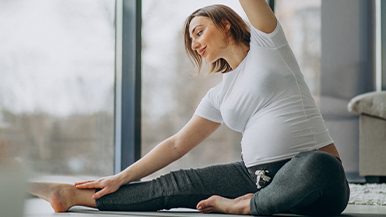Pelvic Floor Muscle Training and Exercise
 Just like the other muscles in your body, your pelvic floor requires regular exercise to build up its strength. Use the following exercises at home or as part of your daily workout routine to strengthen your pelvic floor muscles.
Just like the other muscles in your body, your pelvic floor requires regular exercise to build up its strength. Use the following exercises at home or as part of your daily workout routine to strengthen your pelvic floor muscles.
Kegels
This exercise has long been touted by professionals as one of the most vital exercises in increasing your pelvic floor strength. Follow the instructions below to be sure you’re performing them correctly.
- To perform one contraction, imagine you are stopping the flow of urine, or preventing the passage of wind.
- Performing with an empty bladder, your first goal should be to tighten your pelvic floor muscles for five seconds. Then relax them for five seconds. Try to do five reps on your first day. As you gain confidence from your new routine, aim for for 10 seconds at a time, relaxing for 10 seconds between contractions.
- Be careful not to flex the muscles in your abdomen, thighs or buttocks. Also, avoid holding your breath. Breathe freely during the exercises to keep from stressing the rest of your body.
- Aim for at least three sets of 10 repetitions per day. The beauty of kegels is that they can be done anywhere, anytime. Try performing them during your downtime, such as waiting in line, or sitting at a stoplight.
Squats
Strong glutes and hamstrings are very important to the overall health of your pelvic floor. One of the best exercises that develops these muscles is the deep squat. Follow the instructions below to make sure you are performing squats safely and correctly.
- Stand with feet slightly wider than your hips, toes pointed slightly outward.
- Keep your spine in a neutral position – don’t round your back, and don’t over accentuate the natural arch of your back.
- Extend your arms out straight so they are parallel with the ground, palms facing down.
- Balance your weight on the heels and the balls of your feet.
- Taking a deep breath, begin sending your hips backwards as your knees begin to bend.
- Keep your back straight, and your chest and shoulders up.
- Be sure to keep your knees directly in line with your feet as you squat.
- Continue lowering your hips until they are slightly lower than your knees to perform a deep squat.
- Use your core to push yourself back up, keeping your body weight on your heels.
Transverse Abdominus
Your transverse abdominus, also known as the TA muscle, is the muscle located deep within your core, below the “six-pack” muscles. This muscle is often overlooked, but it serves a vital role. The following steps provide a very basic way to locate your TA muscle and give it a workout:
- Lie on your back, with your knees bent.
- Place your hand on your stomach, just over your belly button.
- Inhale.
- While you exhale, tighten your stomach muscles and pull your belly button inward. You should imagine that you are tightening a corset and flattening your stomach.
- Repeat three sets of 10 reps each.
Multifidus
The multifidus is one of the most important muscles in aiding spinal support. The muscles are attached to the spinal column and are called upon when bending backwards, turning, and bending side to side. Try the exercise below to strengthen the multifidus muscle:
- Lie on your stomach, with your forehead on your hands, or a towel, looking straight down (not to the side).
- Very slowly, rotate your pelvis back slightly so that your tailbone lifts toward the ceiling. This should be a very subtle movement.
- Hold for one second, then rotate your pelvis back to the floor.
- Complete 3 sets of 10 reps each.
It’s important to know that there is no single exercise alone that will strengthen your pelvic floor, as the pelvic floor is supported by many muscles.
Source: http://nafc.org
Florida is a direct access state and does not require physician’s referral for evaluation and treatment by a physical therapist.



